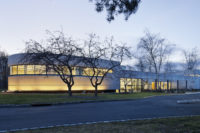Déjà vu all over again.
Years ago, how did alarm companies communicate with field personnel? That question had multiple answers. One was for field personnel to carry pagers and a pocketful of coins for pay phones. While business band radios were available, any user had stiff competition from many other businesses.
Mobile telephone was first introduced by American Telephone & Telegraph Company (AT&T) in 1946 with only 11 or 12 channels in a given area. Users had to wait to use the system and these systems were only able to be powered by car batteries.
It became clear that the alarm industry required its own communications channels to stay connected to field personnel. So, in the late 1960s the industry petitioned the FCC for a number of channels in the 450 to 470 MHz business band. Two “repeater pairs” in the band were granted exclusively and three pair on a shared basis, based on population. These frequencies were meant for voice, with data usage on a secondary basis, using repeaters or simplex (i.e., unit to unit with no repeater).
With the turmoil regarding interconnection of alarm systems with telephone lines back then, an alternative way to transmit alarm signals from a monitored premise to a central station was sought. In the late 1970s, a small number of manufacturers began using “the offsets,” the frequencies just between the voice channels. Some referred to these offsets as “garbage frequencies,” since restrictions to use them were rather difficult.
I was involved in petition the FCC in the early 1980s to change the requirements for the offsets between the alarm frequencies to make them more useful. The result created a whole new venue for alarm transmission. We eased restrictions of these offsets in three ways.
We have seen in natural and manmade disasters over the past two decades that private radio operations can be valuable for maintaining the ability to communicate when you need it the most, because the cellular networks are either damaged or so crowded with traffic that they are unusable during critical periods of time.
First, each customer location need not be licensed but are considered mobiles, not fixed stations. Apart from the cost of licensing each location, we argued that it would create a security issue in that each customer location would become a matter of public record. Second, the power output of each transmitter was set at two watts from the transmitter, not the Effective Radiated Power (ERP) of the antenna system. Third, and perhaps arguably the most important relaxation, is that the height of a customer’s antenna was set at 20 feet above a man-made structure, not above ground.
Today with the overwhelming use of cellular radio to keep alarm companies connected to field personnel, despite my repeated pleas to use these frequencies at least as backup, and with the endless thirst for additional frequencies by other users, we lost our exclusivity. But, while the FCC has opened eligibility for central station voice channels for other users, these channels remain available for eligible alarm companies as well.
Again, I was involved when we fought for and got an FCC rule change to make these channels available for dedicated, higher-powered alarm signaling on a primary basis. Some alarm companies may benefit financially and otherwise through such operations since higher powered radios will travel further and increase reliability.
The central station voice channels can still be useful to alarm companies in their originally intended role for voice communications. We have seen in natural and man-made disasters over the past two decades that private radio operations can be valuable for maintaining the ability to communicate when you need it the most, because the cellular networks are either damaged or so crowded with traffic that they are unusable during critical periods of time.
An incidental benefit of operating on a central station voice channel that is adjacent to the alarm company’s low power signaling operation is that you can become your own best neighbor, as alarm voice or data operations on the voice channel are much more compatible with, and less likely to cause interference to, adjacent low power alarm signals. In some instances, alarm signaling operations are experiencing interference from adjacent non-central station operations.
A company can use the adjacent channels for short range point-to-point voice operation, such as for technicians in the field. Short range usage can have a myriad of applications such as fire testing within a building where cellular coverage is often spotty.
If you go the route of using the adjacent channels, make sure the radio you purchase is “FCC Part 90 Type Accepted.” Radios are available for reasonable cost from a variety of providers.
If you are interested in this use and you are a Listed (by UL, FM or ETL) company, as the alarm industry’s FCC Coordinator, please contact me at ltfiore@aol.com.





